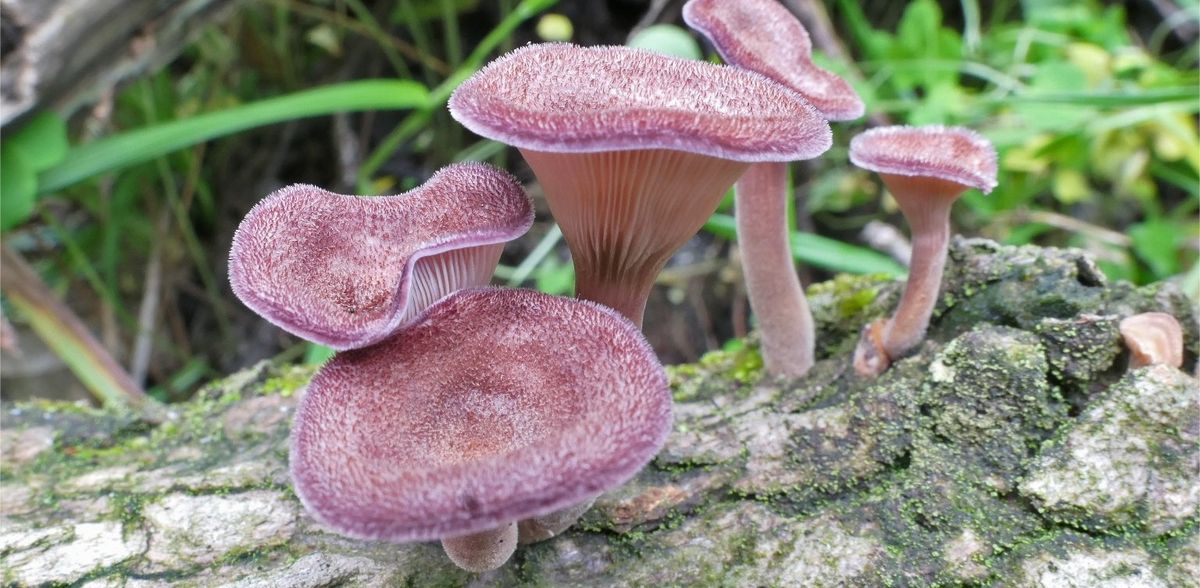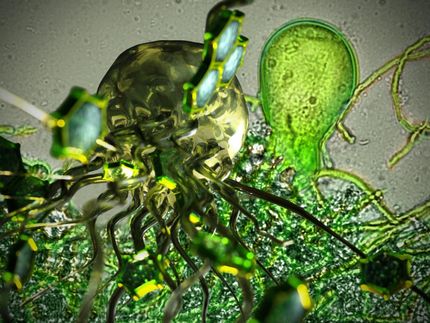Learning from Nature: How a fungus makes a hard job easier
Researchers analyze a fungal biosynthetic pathway and discover a capable enzyme
The investigation of the biosynthesis of panepoxydone, an important substance for biomedical research, in basidiomycetes has revealed a new enzyme as an important catalyst. The results of the researchers from the Leibniz-HKI, the Friedrich Schiller University Jena and the Cluster of Excellence Balance of the Microverse have now been published in the journal "Angewandte Chemie International Edition".
The ruddy panus, scientifically "Panus rudis", is a fungus from the family of stem pore relatives. It is one of the first colonizers of dead deciduous wood, prefers sun-exposed locations and can survive longer dry periods without damage. However, something else makes it interesting for the pharmaceutical industry. It produces panepoxydone, which belongs to the epoxycyclohexenone (ECH) family of substances. These natural substances are known for their bioactivity. Panepoxydone is used in biomedical research to interrupt cellular signaling pathways that play a role in inflammation. In addition, studies with panepoxydone have shown an antitumor effect against various breast cancer cells as well as antimicrobial effects.
Ruddy panus decoded
The chemical synthesis of ECHs is difficult, so it is necessary to resort to the biosynthesis of the substances. However, while the enzymes responsible for ECH synthesis in bacteria and tubular fungi (ascomycetes) are already known, this was not previously the case with the class of fungi known as basidiomycetes. "Even though we know that organisms produce approximately the same active substances, we cannot assume that they do it in the same way," explains Dirk Hoffmeister, Professor of Pharmaceutical Microbiology at the University of Jena and group leader at the Leibniz-HKI.
Professor Yan-Long Yang, first author of the study, came to the University of Jena from Lanzhou University in China as part of a Humboldt Research Fellowship. Together with Dirk Hoffmeister's team, he investigated the biosynthesis of panepoxydone in more detail and discovered the enzyme PanH.
Multiple paths to the same outcome
PanH, an enzyme of the cytochrome P450 group, catalyzes the selective epoxidation of cyclohexenones, which is difficult to achieve by chemical synthesis but is essential for the efficacy of the substances. "The collaboration with Yan-Long Yang was very productive. The exchange of knowledge and methodology worked very well in both directions and both sides made good progress," Hoffmeister is pleased to report. The result confirms the assumption that not all similar active substances have to be produced by the organisms in the same way. The epoxidation of ECHs in basidiomycetes actually developed in parallel with bacteria and ascomycetes and uses different enzymes.
An enzyme as a multi-talent
"The next question Yang asked himself was whether the enzyme can also carry out this reaction with other molecules," reports Hoffmeister. "And this is the really relevant aspect of the study: if you give the enzyme substrates that do not occur naturally in the cell, epoxidation usually occurs anyway, so the enzyme works quite unspecifically." By varying the side chain of the substrates, the team was able to produce a small library of substances. "This enabled us to show that the enzyme is a useful and versatile catalyst with biotechnological significance." Epoxidation is insertion of an oxygen atom into a molecule, and because single oxygen atoms are quite reactive, this is a huge challenge that needs to be overcome by learning how nature does it. This is peculiar interesting as many pharmaceuticals contain oxygen.
"The long-term goal is to use this enzyme to produce a larger library of substances and test them for improved and more specific activities in the hope of a pharmaceutical application," concludes Hoffmeister.
Original publication
Yan‐Long Yang, Man Zhou, Lin Yang, Markus Gressler, Johannes Rassbach, Jacob M. Wurlitzer, Ying Zeng, Kun Gao, Dirk Hoffmeister; "A Mushroom P450‐Monooxygenase Enables Regio‐ and Stereoselective Biocatalytic Synthesis of Epoxycyclohexenones"; Angewandte Chemie International Edition, Volume 62, 2023-10-31
Most read news
Original publication
Yan‐Long Yang, Man Zhou, Lin Yang, Markus Gressler, Johannes Rassbach, Jacob M. Wurlitzer, Ying Zeng, Kun Gao, Dirk Hoffmeister; "A Mushroom P450‐Monooxygenase Enables Regio‐ and Stereoselective Biocatalytic Synthesis of Epoxycyclohexenones"; Angewandte Chemie International Edition, Volume 62, 2023-10-31
Organizations
Other news from the department science

Get the life science industry in your inbox
By submitting this form you agree that LUMITOS AG will send you the newsletter(s) selected above by email. Your data will not be passed on to third parties. Your data will be stored and processed in accordance with our data protection regulations. LUMITOS may contact you by email for the purpose of advertising or market and opinion surveys. You can revoke your consent at any time without giving reasons to LUMITOS AG, Ernst-Augustin-Str. 2, 12489 Berlin, Germany or by e-mail at revoke@lumitos.com with effect for the future. In addition, each email contains a link to unsubscribe from the corresponding newsletter.






















































